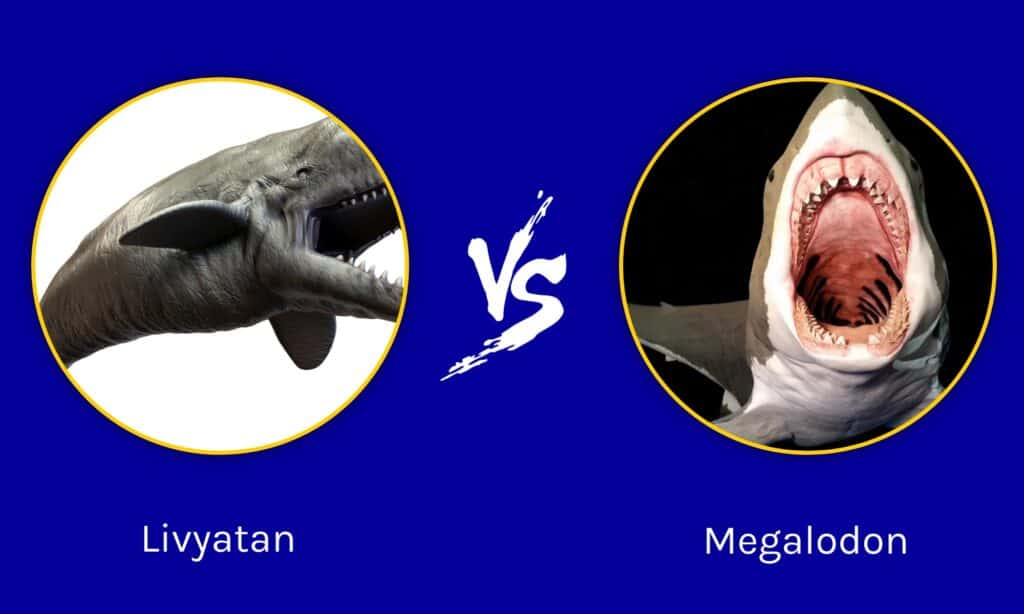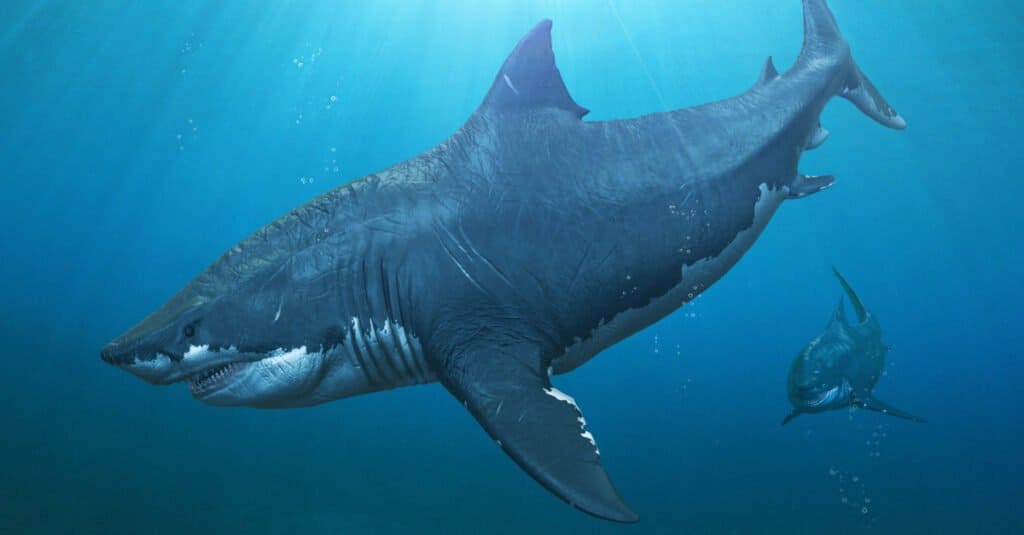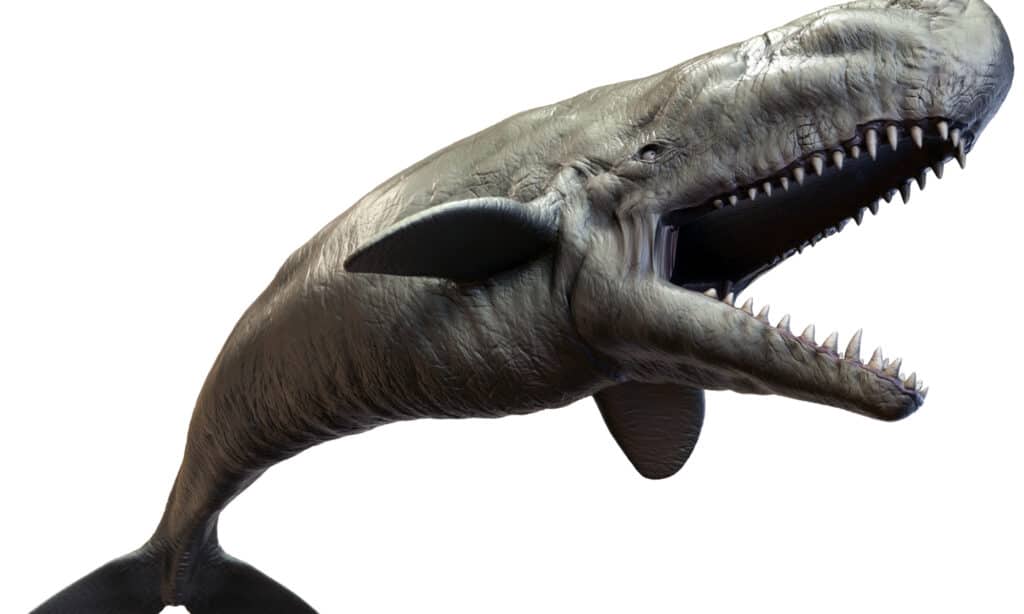Whales and sharks are competitors and enemies in the present, and that is nothing new. Millions of years ago, the hunting whale called Livyatan (L. melvillei) had to compete with the massive shark called megalodon (O. megalodon) for resources. These two lived together over 9 million years ago, but the megalodon was the last one standing, living as few as 3.6 million years ago. That begs the question, which creature would win a Livyatan vs megalodon fight?
Take a look as we examine the Livyatan and megalodon and show you which of these creatures came out on top!
Comparing a Livyatan and a Megalodon

| Livyatan | Megalodon | |
|---|---|---|
| Size | Weight: 62.8 tons Length: 44ft-57ft estimated | Weight: 50 tons Length: upwards of 67 feet |
| Speed and Movement Type | – 5-20 mph estimated relative to sperm whales – Propels body with tail in an up-and-down motion | – 11 mph – Undulating, side-to-side motions of the body and tail are used for propulsion |
| Senses | – Likely used echolocation like sperm whales – Good hearing – Probably had a bad sense of taste and smell | – A highly attuned sense of smell – Great vision, especially in low-light settings – Hearing is strong enough to hear splashing prey – Ampullae of Lorenzini helped detect living creatures. |
| Defenses | – Incredibly large size – Speed bursts to escape predators | – Massive size – Speed |
| Offensive Capabilities | – Massive teeth in both jaws – Teeth measured over 1ft in length – Powerful bite that dug into preys and ripped away large amounts of flesh | – Jaws exceeding 6.5 feet in diameter, possibly 9 feet. – 250 teeth, about 7-inches long each – Bite exceeding 108,000N – High swim speed |
| Predatory Behavior | – Apex predator – Pursuit predation of large creatures such as whales, sharks, dolphins, and more | – Stealthy predatory that ambushed prey |
What Are Key Differences Between a Livyatan and a Megalodon?

Megalodon was a monstrous shark that was even more dangerous than any shark today
©Herschel Hoffmeyer/Shutterstock.com
The major differences between Livyatan and megalodon lie in their morphology and sensory abilities. Livyatan was essentially a very large sperm whale with large teeth on the upper and lower half of their jaws that used echolocation to find prey, and megalodon was similar to a great white shark or mako shark with a torpedo-shaped body and very keen senses of smell and the ability to detect electrical fields from prey.
Furthermore, the Livyatan propelled itself through water by waving its tail up and down while the megalodon moved its tail side to side. These are the most obvious differences between the creatures, but several others exist. We are going to examine the major differences between these animals in light of their ability to do battle.
What Are the Key Factors in a Fight Between a Livyatan and a Megalodon?

Megalodon had massive jaws and sharp teeth with which to kill its foes
©Warpaint/Shutterstock.com
When trying to figure out which animal wins during a massive fight, we have to think about the big picture. That means focusing on a handful of key factors that would have a massive impact on the battle. In this case, we’re going to focus on physical elements as well as the intangibles like combat skills.
We’ll assign advantages to each animal throughout this comparison and show you ways that each animal could come out on top.
Livyatan vs Megalodon: Size
The Livyatan was larger than the megalodon. According to estimates based on the size of a recovered skull, this animal weighed up to 62 tons and grew 57 feet in length. The megalodon could reach weights of 50 tons (and possibly beyond) and would grow up to 67 feet long.
Thus, the more accurate way to look at the situation is that the megalodon was possibly longer but we’ll take more conservative estimates of the Megalodon’s size and classify it as less heavy than Livyatan.
Livyatan has the size advantage over megalodon.
Livyatan vs Megalodon: Speed and Movement
A Livyatan was probably faster than the megalodon. Again, we are dealing with estimates based on existing animals in many cases. It’s believed that the Livyatan could move at similar speeds to sperm whales, between 5 and 20 mph. Megalodons could move at about 11 mph, perhaps faster when closing on prey.
Livyatan has the advantage in terms of speed.
Livyatan vs Megalodon: Senses
Megalodon had amazing senses that they could use to hunt their prey. They had an incredibly sensitive sense of smell along with great vision and hearing. Moreover, they can detect electrical fields coming from prey via the ampullae of Lorenzini.
Livyatan’s senses were not as good. They used echolocation to find prey and communicate with others, and they had good hearing. However, their senses of taste and smell were thought to be poor.
Megalodon has the advantage in senses.
Livyatan vs Megalodon: Physical Defenses

Livyatan has teeth that could reach 14 inches in length.
©Herschel Hoffmeyer/Shutterstock.com
The Megalodon was a very large apex predator in the ocean waters, and its size made most enemies steer clear of it. However, it also had enough speed to outrun some foes as well. Livyatan was even larger and more imposing. It was probably the largest creature in the ocean during its lifetime, and it was not a baleen whale with bristle-like teeth. A Livyatan could bite into or through most creatures!
Livyatan vs Megalodon: Combat Skills
Megalodon was even deadlier than the most powerful sharks alive today. It had an enormous size to go with its incredible hunting senses. This shark would try to sneak up on its foes and bite them in their chest cavities, killing them by crushing organs and exsanguination.
The Livyatan wasn’t that much different in how it attacked. This large, surprisingly speedy creature probably hunted through pursuit predation, wearing down other whales or dolphins during a chase and then drowning them. For smaller sharks, it would probably just bite them using its massive teeth that measured over a foot in length.
Who Would Win in a Fight Between a Livyatan and a Megalodon?

Livyatan would emerge victorious in the battle of these two sea giants!
©Herschel Hoffmeyer/Shutterstock.com
A Livyatan would win a fight against a megalodon. The Livyatan has the size and speed advantage, bigger teeth, and it has endurance to last through a long fight. Another problem for the megalodon stems from the way that megalodons attack. They prefer to dig into the stomachs of their prey. In this case, they’re going to get blood and blubber on their first few bites, and that’s not going to help it kill a massive whale.
Even if it managed to sneak up on the Livyatan and land the first attack, it would not benefit them much. The fight would turn into a bite-for-bite trade, and the Livyatan can take more damage than a megalodon.
The truth is that these creatures probably traded kills, and one never dominated the other with any great frequency. Sharks are brutal and crafty, and whales might not be able to catch a crafty megalodon. Still, if we had to pick a winner, the Livyatan gets the nod.
Could Another Animal Take Down a Megalodon?
We tried to find another animal that could have taken down the Livyatan and just couldn’t do it. They ruled the seas during their time and swam at the top of the prehistoric underwater food chain. So, our attention turns back to the mighty megalodon. Were there any other monsters of the sea more fierce than Livyatan? What should the megalodon take on next? What about a giant extinct squamate reptile like the Mosasaurus?
The megalodon was a giant shark that got up to 67 feet and 65,000 pounds. The Mosasaurus grew up to 56 feet and weighed 40,000 pounds – not too shabby! Both animals could swim up to 30 mph, so they would tie in a race. The Mosasaurus would also win the agility category with its large pectoral girdles that enabled it to make rapid directional changes.
Megalodon was made for killing larger prey with jaws that opened nearly 7 feet wide and full of 250 horrible teeth – some being seven inches long! Mosasaurus had a rigid skull and a tapered, crocodile-like jaw that could only open 3 feet wide. Its 40 – 50 teeth couldn’t compare to the Megalodon’s. The bite-force comparison doesn’t look good for the monster reptile either. Mosasaurus bite force of 16,000 PSI was formidable, but the Megalodon’s 41,000 PSI bite is the strongest of any known animal.
The Mosasaurus were more experienced in these sorts of battles because they often fought each other. This enabled them to develop the ability to come up with specific strategies to battle different animals – they were highly intelligent! The Megalodon was more straightforward similar to modern-day sharks.
Would size and bite force make the difference in this fight? Probably, yes. The Megalodon was just too big and powerful for the Masasaurus, meaning that it would take the big lizard down with one massive bite.
Did Megalodon Eat Livyatan?
The short answer is no. Although both Livyatan and Megalodon inhabited the oceans during a warmer period, preying on a variety of large marine creatures, megalodon did not eat Livyatan.
In fact, both Livyatan and Megalodon thrived in ancient, warmer oceans, preying on the same various large marine creatures, including whales, dolphins, porpoises, pinnipeds, sea turtles, sharks, and possibly even smaller members of their own species.
Although both Livyatan and Megalodon occupied the role of apex predators within their distinct marine environments, their main dietary focus most likely remained on other marine mammals rather than each other.
The photo featured at the top of this post is © Herschel Hoffmeyer/Shutterstock.com
Thank you for reading! Have some feedback for us? Contact the AZ Animals editorial team.






